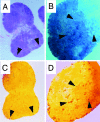Human herpesvirus 6A accelerates AIDS progression in macaques
- PMID: 17360322
- PMCID: PMC1829265
- DOI: 10.1073/pnas.0700929104
Human herpesvirus 6A accelerates AIDS progression in macaques
Abstract
Although HIV is the necessary and sufficient causative agent of AIDS, genetic and environmental factors markedly influence the pace of disease progression. Clinical and experimental evidence suggests that human herpesvirus 6A (HHV-6A), a cytopathic T-lymphotropic DNA virus, fosters the progression to AIDS in synergy with HIV-1. In this study, we investigated the effect of coinfection with HHV-6A on the progression of simian immunodeficiency virus (SIV) disease in pig-tailed macaques (Macaca nemestrina). Inoculation of HHV-6A resulted in a rapid appearance of plasma viremia associated with transient clinical manifestations and followed by antibody seroconversion, indicating that this primate species is susceptible to HHV-6A infection. Whereas animals infected with HHV-6A alone did not show any long-term clinical and immunological sequelae, a progressive loss of CD4(+) T cells was observed in all of the macaques inoculated with SIV. However, progression to full-blown AIDS was dramatically accelerated by coinfection with HHV-6A. Rapid disease development in dually infected animals was heralded by an early depletion of both CD4(+) and CD8(+) T cells. These results provide in vivo evidence that HHV-6A may act as a promoting factor in AIDS progression.
Conflict of interest statement
The authors declare no conflict of interest.
Figures



Similar articles
-
Evolution of SIV toward RANTES resistance in macaques rapidly progressing to AIDS upon coinfection with HHV-6A.Retrovirology. 2009 Jul 2;6(Suppl 2):61. doi: 10.1186/1742-4690-6-61. Retrovirology. 2009. PMID: 19573243 Free PMC article.
-
In vitro susceptibility of Macaca nemestrina to human herpesvirus 6: a potential animal model of coinfection with primate immunodeficiency viruses.AIDS Res Hum Retroviruses. 1994 Feb;10(2):181-7. doi: 10.1089/aid.1994.10.181. AIDS Res Hum Retroviruses. 1994. PMID: 8198870
-
Human herpesvirus 6 variant a infects human term syncytiotrophoblasts in vitro and induces replication of human immunodeficiency virus type 1 in dually infected cells.J Med Virol. 2002 May;67(1):67-87. doi: 10.1002/jmv.2194. J Med Virol. 2002. PMID: 11920820
-
Recent developments in animal models for human herpesvirus 6A and 6B.Curr Opin Virol. 2014 Dec;9:97-103. doi: 10.1016/j.coviro.2014.09.012. Epub 2014 Oct 14. Curr Opin Virol. 2014. PMID: 25462440 Free PMC article. Review.
-
Molecular biology of human herpesviruses 6A and 6B.Infect Agents Dis. 1993 Dec;2(6):343-60. Infect Agents Dis. 1993. PMID: 8012736 Review.
Cited by
-
Comparative Analysis of Roseoloviruses in Humans, Pigs, Mice, and Other Species.Viruses. 2019 Nov 30;11(12):1108. doi: 10.3390/v11121108. Viruses. 2019. PMID: 31801268 Free PMC article. Review.
-
Classification of HHV-6A and HHV-6B as distinct viruses.Arch Virol. 2014 May;159(5):863-70. doi: 10.1007/s00705-013-1902-5. Epub 2013 Nov 6. Arch Virol. 2014. PMID: 24193951 Free PMC article. Review.
-
Virion incorporation of integrin α4β7 facilitates HIV-1 infection and intestinal homing.Sci Immunol. 2017 May 12;2(11):eaam7341. doi: 10.1126/sciimmunol.aam7341. Sci Immunol. 2017. PMID: 28763793 Free PMC article.
-
The latent human herpesvirus-6A genome specifically integrates in telomeres of human chromosomes in vivo and in vitro.Proc Natl Acad Sci U S A. 2010 Mar 23;107(12):5563-8. doi: 10.1073/pnas.0913586107. Epub 2010 Mar 8. Proc Natl Acad Sci U S A. 2010. PMID: 20212114 Free PMC article.
-
Advances in the Characterization of the T-Cell Response to Human Herpesvirus-6.Front Immunol. 2018 Jun 25;9:1454. doi: 10.3389/fimmu.2018.01454. eCollection 2018. Front Immunol. 2018. PMID: 29988505 Free PMC article. Review.
References
-
- Salahuddin SZ, Ablashi DV, Markham PD, Josephs SF, Sturzen-negger S, Kaplan M, Halligan G, Biberfeld P, Wong-Staal F, Kramarsky B, Gallo RC. Science. 1986;234:596–601. - PubMed
-
- Ablashi DV, Balachandran N, Josephs SF, Hung CL, Krueger GRF, Kramarski B, Salahuddin SZ, Gallo RC. Virology. 1991;184:545–552. - PubMed
-
- Yamanishi K, Okuna T, Shiraki K. Lancet. 1988;1:1065–1067. - PubMed
-
- Lusso P, Gallo RC. Immunol Today. 1995;16:67–71. - PubMed
Publication types
MeSH terms
Substances
Grants and funding
LinkOut - more resources
Full Text Sources
Other Literature Sources
Medical
Research Materials

